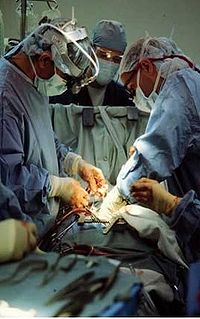
Photo from wikipedia
J Thorac Dis 2020 | http://dx.doi.org/10.21037/jtd-20-1386 In surgical treatment of lung cancer, uniportal videoassisted thoracic surgery (U-VATS) has been gradually increasing as a minimally invasive surgical treatment, as well as… Click to show full abstract
J Thorac Dis 2020 | http://dx.doi.org/10.21037/jtd-20-1386 In surgical treatment of lung cancer, uniportal videoassisted thoracic surgery (U-VATS) has been gradually increasing as a minimally invasive surgical treatment, as well as robot assisted thoracic surgery (RATS), in thoracic surgery. Reports on several treatment outcomes of U-VATS suggest that, at present, at least, perioperative complications, mortality, and early recurrence after surgery may be comparable to those of conventional multiportal VATS (M-VATS) (1-3). Although there have been fewer reports on the prognosis, outcomes of early non-small cell lung cancer comparable to those acquired by M-VATS may increase based on our experience. In this report, the comparative study of the short-term treatment outcome of lung cancer between U-VATS and M-VATS performed at the Karolinska Institute in Sweden is demonstrated (4). The study design was an institutional observational cohort study, and interestingly carcinoid accounted for 8–9% of the surgical cases in both groups that were included pathological stage I to IV. The disease stage was more than IIIA in 8.2% in the U-VATS group, being higher than that (4.7%) in the M-VATS group. Preoperative chemotherapy or radiotherapy was performed in 3.3 and 1.9% of all cases in the U-VATS and M-VATS groups, respectively. Figure 3 shows the 2-year survival rate in the U-VATS and M-VATS groups. The survival rate was slightly lower in the M-VATS group. Early recovery after surgery, postoperative wound pain relief, and the esthetic satisfaction of patients are considered advantages of U-VATS, compared to those of M-VATS, but questions remain whether there is a statistically significant difference. In our study on a comparison of the wound pain relief effect between the 2 surgical procedures, a significant difference was noted in the wound pain relief effect on postoperative month 2 and thereafter, rather than early after surgery (5). The most important point is that a higher rate of direct discharge to home after surgery in the U-VATS than M-VATS group was presented in this report, but data on the presence or absence of the postoperative use of anti-inflammatory analgesics and opioid analgesics considered to be related to the rate of direct discharge to home after surgery, surgical factors (operative time and blood loss, etc.), and data on wound pain relief were not disclosed and it would have been better to describe comments on the reason for the presence of reoperation by U-VATS performed in approximately 5%. Moreover, in the Karolinska Institute, postoperative management is performed following the protocol termed enhanced recovery after thoracic surgery (ERATS). Consequently, due to introduction of this protocol, the rate of direct discharge to home was 76.2% in the U-VATS group, being clearly higher than that (62.1%) in the M-VATS group, and observation of the significance in the U-VATS group based on this postoperative low-invasiveness evaluation Editorial Commentary
Journal Title: Journal of thoracic disease
Year Published: 2020
Link to full text (if available)
Share on Social Media: Sign Up to like & get
recommendations!